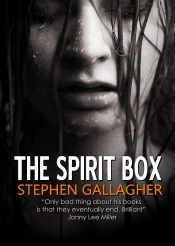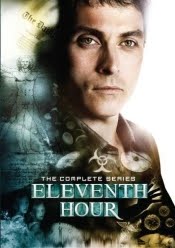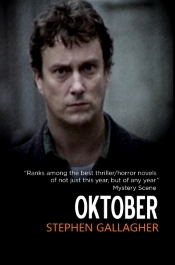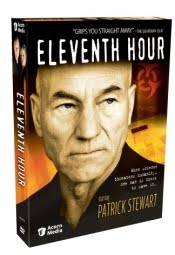Upcoming anthology from Tor Forge... I'm in it
Saturday 21 February 2015
Friday 20 February 2015
The day I was offered THE PRISONER
It was back in the early 90's. I was at a meeting with Debra Allanson down in Soho Square. Her boss at the time was David Cunliffe, and he did a drop-by. He said they had access to The Prisoner TV rights and would I be interested in tackling a new version?
I didn't even hesitate. I said I wouldn't touch it with a bargepole. I said that if ever there was a remake that you couldn't take on and win, this was the one.
It wasn't just a casual enquiry on their part. The drive to remake The Prisoner went on for decades. I heard they went on to have a discussion with the late Lelan Rogers, record producer and brother of the more famous Kenny, about an Americanised take on the show. But that foundered. Then in the mid-90s all the ITC rights went to Polygram and there was talk about a feature with a Patrick McGoohan screenplay. Mel Gibson was supposed to be attached at one point. Then there was the version with the Christopher McQuarrie script.
I thought about it afterwards, obviously, and played those head-games where you imagine what you might have done with it. The lead character's grown-up daughter contrives to get herself sent to the Village as part of a plan to liberate the father she's never met, and who hasn't bent an inch in all those years. He takes her appearance as yet another trick to break him. She starts to wonder if he's right, and whether her choices have actually been her own. And at the end of the day, true to the core value of the original: no straight answers.
But I've never been sorry that I turned down the chance. Talk about a poisoned chalice. Despite a stellar cast and a thoughtful script from Bill Gallagher (no relation), the choices that drove the 2009 ITV miniseries place it alongside the Fiennes/Thurman Avengers movie in the Gallery of the Misconceived. Listlessly shot in a threadbare Namibian Butlins', it's what you get when your producers haven't grasped what makes a property tick.
The Prisoner was a huge, flawed, sprawling, psychotic explosion centred on the personality of its producer/star. Take away the things that gave it unique life - McGoohan, the location, its 1960s psychedelic sensibility - and what you're left with is a story premise that, on its own, was good for one episode of Danger Man.
I didn't even hesitate. I said I wouldn't touch it with a bargepole. I said that if ever there was a remake that you couldn't take on and win, this was the one.
It wasn't just a casual enquiry on their part. The drive to remake The Prisoner went on for decades. I heard they went on to have a discussion with the late Lelan Rogers, record producer and brother of the more famous Kenny, about an Americanised take on the show. But that foundered. Then in the mid-90s all the ITC rights went to Polygram and there was talk about a feature with a Patrick McGoohan screenplay. Mel Gibson was supposed to be attached at one point. Then there was the version with the Christopher McQuarrie script.
I thought about it afterwards, obviously, and played those head-games where you imagine what you might have done with it. The lead character's grown-up daughter contrives to get herself sent to the Village as part of a plan to liberate the father she's never met, and who hasn't bent an inch in all those years. He takes her appearance as yet another trick to break him. She starts to wonder if he's right, and whether her choices have actually been her own. And at the end of the day, true to the core value of the original: no straight answers.
But I've never been sorry that I turned down the chance. Talk about a poisoned chalice. Despite a stellar cast and a thoughtful script from Bill Gallagher (no relation), the choices that drove the 2009 ITV miniseries place it alongside the Fiennes/Thurman Avengers movie in the Gallery of the Misconceived. Listlessly shot in a threadbare Namibian Butlins', it's what you get when your producers haven't grasped what makes a property tick.
The Prisoner was a huge, flawed, sprawling, psychotic explosion centred on the personality of its producer/star. Take away the things that gave it unique life - McGoohan, the location, its 1960s psychedelic sensibility - and what you're left with is a story premise that, on its own, was good for one episode of Danger Man.
Wednesday 18 February 2015
"One of the Strangest Dramas in the Small Screen's History"
I was looking for something in the archives when I came across this little snippet, and thought I'd share. It fairly counts as contemporary, since the episode seems to air every other week on ITV3...
Of The Cup of Silence, December 23rd's feature-length Rosemary & Thyme Christmas Special, Victoria Segal wrote in The Sunday Times:
"Much as I hate to disillusion a journalist, no exotic substances were involved. That's what my world looks like all the time."
Of The Cup of Silence, December 23rd's feature-length Rosemary & Thyme Christmas Special, Victoria Segal wrote in The Sunday Times:
…Superficially it resembles Women’s Institute television, a comfortable shoe of a show, yet close inspection shows Rosemary & Thyme to be one of the strangest dramas in the small screen’s history… for all the intrigue you quickly believe this is written by people whose horticultural interests extend to high-end herbal exotics. Consider the evidence: gratuitous shots of mushrooms accompanied by sinister music; a group of B-movie fans re-creating Peter Cushing films in the hotel’s cellar; and best of all, a prog-rock reference so incongruous the writer must have had a bet. Forget Midsomer Murders and feed your head.And I wrote:
"Much as I hate to disillusion a journalist, no exotic substances were involved. That's what my world looks like all the time."
Monday 16 February 2015
Sebastian Blogger
I've put together a second blog in which I've pulled together all my material on the Sebastian Becker books and short stories. This is what it's currently looking like:
Saturday 14 February 2015
Arthur and Sherlock
 Most of my background knowledge on Arthur Conan Doyle comes from his autobiography Memories and Adventures, and from the 1949 biography by John Dickson Carr. I haven’t read the 1995 bio by Michael Coren but I understand that it goes further into the Doyle/Joseph Bell connection - the relationship that inspired the Murder Rooms BBC series - than most of the others. What I’ve read of the debate suggests that there are various camps arguing for a single model for Holmes (Bell, Doyle himself) when it’s perfectly obvious to any working writer that every character has multiple sources.
Most of my background knowledge on Arthur Conan Doyle comes from his autobiography Memories and Adventures, and from the 1949 biography by John Dickson Carr. I haven’t read the 1995 bio by Michael Coren but I understand that it goes further into the Doyle/Joseph Bell connection - the relationship that inspired the Murder Rooms BBC series - than most of the others. What I’ve read of the debate suggests that there are various camps arguing for a single model for Holmes (Bell, Doyle himself) when it’s perfectly obvious to any working writer that every character has multiple sources.I read the Holmes short stories in my early teens and it was probably around then that I saw the Douglas Wilmer/Nigel Stock BBC adaptations. I reckon there's always a special place in your heart for the actor who first introduces you to the character, much as Doctor Who fans divide along generational lines and four generations of adolescent boys lusted after whoever was wearing the catsuit (Gale, Peel, King or Lumley) in The Avengers when the hormones hit.
 I can’t say I was ever the rabid kind of Holmes fan. I knew a boy who was, to the extent of taking up the violin because of it. If he's stayed true to form he’s probably a coke fiend by now. I liked a core of the shorts and none of the novels, which I felt lacked the tight structure and single focus that made the stories work. As for the rest of Doyle's output: I read Tales of Medical Life but I skipped Brigadier Gerard. I read some of the boxing stories. My big Conan Doyle book was The Lost World – loved it then, love it now. In fact I never thought about it until this moment, but now I count I’ve got at least five different editions of it scattered about the house, including a first. I even slogged my way through The Land of Mist because it had Professor Challenger in it, which is a serious test of affection.
I can’t say I was ever the rabid kind of Holmes fan. I knew a boy who was, to the extent of taking up the violin because of it. If he's stayed true to form he’s probably a coke fiend by now. I liked a core of the shorts and none of the novels, which I felt lacked the tight structure and single focus that made the stories work. As for the rest of Doyle's output: I read Tales of Medical Life but I skipped Brigadier Gerard. I read some of the boxing stories. My big Conan Doyle book was The Lost World – loved it then, love it now. In fact I never thought about it until this moment, but now I count I’ve got at least five different editions of it scattered about the house, including a first. I even slogged my way through The Land of Mist because it had Professor Challenger in it, which is a serious test of affection. The Holmes stories that have stayed with me all turned on some elegant and ingenious element, (the fire trick in A Scandal in Bohemia, the goose trick in The Blue Carbuncle) but I think I was never quite convinced by Holmes himself. I saw him as a group of eccentric attributes that never quite cohered into a believable personality. In retrospect I think the stories succeeded because Holmes and Watson together make a single character, divided for the purposes of narrative development. What I liked about Murder Rooms was that it dispensed with the fictional figureheads while occupying the same dramatic ground, effectively reinventing the whole thing. Bell and Doyle hit all the same buttons as Holmes and Watson, but with none of the limitations.
The Holmes stories that have stayed with me all turned on some elegant and ingenious element, (the fire trick in A Scandal in Bohemia, the goose trick in The Blue Carbuncle) but I think I was never quite convinced by Holmes himself. I saw him as a group of eccentric attributes that never quite cohered into a believable personality. In retrospect I think the stories succeeded because Holmes and Watson together make a single character, divided for the purposes of narrative development. What I liked about Murder Rooms was that it dispensed with the fictional figureheads while occupying the same dramatic ground, effectively reinventing the whole thing. Bell and Doyle hit all the same buttons as Holmes and Watson, but with none of the limitations.The first time that I felt the character of Holmes approached reality onscreen was in Billy Wilder’s The Private Life of Sherlock Holmes – neither a slavish copy nor a spoof, more of a jazz riff on Doyle’s tune. Not the definitive big-screen Holmes but for my money the most satisfying. If Doyle had felt able to develop the character with the same kind of freedom, maybe he wouldn’t have grown to detest his own creation so.
At this time of writing we have two very different screen Holmeses to consider - three, if you count Robert Downey Jr's charismatic man of action, an interpretation that drew criticism but which for my money got further under the skin of the character than any of the pipe-and-deerstalker brigade. I mean, Roger Moore? Charlton Heston? No offence to those gentlemen but... FFS... it's like Holmes has always been fair game to any fast-moving wheeler-dealer producer with access to tax shelter money and cheap studio time.
TV offers us two radically different takes in the form of the BBC's Sherlock and CBS's Elementary. Note to fans; it's OK to watch both. Benedict Cumberbatch's version is dazzling performance art, a fascinating and superhuman creation that you'd never expect to meet in life. Jonny Lee Miller's awkward, vulnerable and self-aware Sherlock is something else; tightly-wound and earnest, more human than superman, more psychological truth than fireworks.
 Doyle was never what you’d call a psychological writer. His was a world of concrete certainties. His certainties were entirely his own and he owed them to nobody – he believed in fairies and Empire and you could hardly call such a combination the mark of a conventional thinker – but in all his life and deeds he seems to have been free of any element of self-doubt. Which is great for a crusader and a champion, both of which roles he played in later life, but something of a hindrance when sitting down to imagine characters of conflict and complexity.
Doyle was never what you’d call a psychological writer. His was a world of concrete certainties. His certainties were entirely his own and he owed them to nobody – he believed in fairies and Empire and you could hardly call such a combination the mark of a conventional thinker – but in all his life and deeds he seems to have been free of any element of self-doubt. Which is great for a crusader and a champion, both of which roles he played in later life, but something of a hindrance when sitting down to imagine characters of conflict and complexity.My private theory on Doyle is that inside his head he was always twelve years old. He wrote stories. He dreamed of dinosaurs. He was idealistic in an old-fashioned, chivalric, Walter Scott kind of a way. He carried boxing gloves in his luggage and challenged other boys to fights. He started to learn the banjo in middle age. When he went to visit the trenches in 1916 he designed himself a uniform.
Friday 13 February 2015
Chimera: the making of a TV Monster
Here's a follow-up to this post from a couple of weeks back, in which discovering the whereabouts of an old colleague inspired me to revisit one of my early projects.
During Chimera's pre-production and filming I hopped around with my then state-of-the-art camcorder and collected footage which then sat, unshown and unseen, until Revelation Films secured DVD rights to the show after long and patient effort.
I offered the footage for use as a possible extra feature - in fact it made three featurettes. I recorded the commentaries on a deceptively tiny digital recorder in my Los Angeles apartment, working around the distraction of hummingbirds outside the window and the noise from my landlord's leafblower on the drive, and emailed them back to the UK.
This is the first of the three. If you want to see the others, it won't ruin you to buy the disc. Which also includes a PDF of the earlier radio adaptation script, and the show's original Press Kit, and a couple of other things I don't even remember. "Contains moderate gore".
Incidentally, with so much nostalgia-driven stuff on the blog of late you might be forgiven for thinking I haven't been working on anything new. Not so. I spent most of 2014 developing a network project and working between drafts on a new Becker novel that I delivered last month. Development happens off the radar, so there's nothing to say about that right now. And it's too soon to give you any news on the novel.
But if you'd rather imagine me idle, feel free.
During Chimera's pre-production and filming I hopped around with my then state-of-the-art camcorder and collected footage which then sat, unshown and unseen, until Revelation Films secured DVD rights to the show after long and patient effort.
I offered the footage for use as a possible extra feature - in fact it made three featurettes. I recorded the commentaries on a deceptively tiny digital recorder in my Los Angeles apartment, working around the distraction of hummingbirds outside the window and the noise from my landlord's leafblower on the drive, and emailed them back to the UK.
This is the first of the three. If you want to see the others, it won't ruin you to buy the disc. Which also includes a PDF of the earlier radio adaptation script, and the show's original Press Kit, and a couple of other things I don't even remember. "Contains moderate gore".
Incidentally, with so much nostalgia-driven stuff on the blog of late you might be forgiven for thinking I haven't been working on anything new. Not so. I spent most of 2014 developing a network project and working between drafts on a new Becker novel that I delivered last month. Development happens off the radar, so there's nothing to say about that right now. And it's too soon to give you any news on the novel.
But if you'd rather imagine me idle, feel free.
Crusoe to UKTV
From C21 Media:
More here.
UKTV has picked up a trio of scripted series from UK-based producer and distributor Power, including NBC drama Crusoe... The 13-part adaptation of Daniel Defoe’s classic novel stars Sam Neil and Sean Bean and was originally commissioned by NBC in the US and produced by Power.Crusoe was last shown on British terrestrial TV as a Christmas season special on (if I'm remembering correctly) Channel 5. The shows have been acquired for UKTV's Drama channel, which is free-to-air on Freeview.
More here.
Monday 2 February 2015
From Chad to Cumberbatch
 Back in 1990 I drove down to Pinewood Studios for the first of several visits to the workshops of Bob Keen's Image Animation, a special effects company that had supplied prosthetics and animatronics for Richard Stanley's Hardware and Clive Barker's Hellraiser movies.
Back in 1990 I drove down to Pinewood Studios for the first of several visits to the workshops of Bob Keen's Image Animation, a special effects company that had supplied prosthetics and animatronics for Richard Stanley's Hardware and Clive Barker's Hellraiser movies. It was all a bit of a scramble. The script of Chimera had been doing the rounds of UK TV companies for over a year. First it had been picked up by development producer Simon Moorhead, then Morse producers Zenith had thrown their weight behind it.
Each of the majors had turned us down and we'd all but given up hope when a foundering project created a sudden gap in Anglia TV's production schedule. That misfortune was our opportunity. We found ourselves with a four-hour monster show to make and not much time to make it in.
It was a great experience for me. I got to hang out everywhere, and it would be a long time before I'd again get to be so hands-on in a show. The design and building of the creature is covered in one of the featured extras on the Chimera DVD, which can now be had for less than a fiver if you shop in the right place.
Our project was handled for Image Animation by Simon Sayce and our creature designer was an FX artist introduced to me only as Little John. They're both in the documentary, and that's Little John in the picture above. Behind the Chad mask is movement specialist Douglas Mann.
In the years that followed, I often wondered what had become of some of our team. In Little John's case, Google was no help. He was even billed as Little John onscreen and on the IMDB, where his credits stopped soon after. When someone seems to vanish from the record, you fear the worst; it's a precarious business, even for the most talented.
Last week, a development; thanks to the combined research efforts of the Demonic Offspring and filmmaker Paul Campion, I learned that not only does Little John have a surname but that I failed to stop his career in its tracks.
John Cormican is now the senior sculptor for Madame Tussaud Studios, travelling the globe and handling many of their high-profile projects. In the video he takes us through the measuring and modelling of Benedict Cumberbatch's figure, much as he did for my camera in the Pinewood workshop all those years ago. Look at the work here and you'll see why he's reached the top of his profession.
(Or if you're one of those lured here by the Benedict factor, take whatever you need)
All this pleases me more than I can tell you.
UPDATE: Well, this is just a bit spooky; from the Time Celebrity Newsfeed, "Watch Benedict Cumberbatch Pretend his Name is Chad".
Sunday 1 February 2015
The Doll Collection
Starred review from Publishers Weekly for The Doll Collection, edited by the invincible Ellen Datlow and available next month from Tor.
PS I'm in it.
PS I'm in it.
Subscribe to:
Posts (Atom)






































